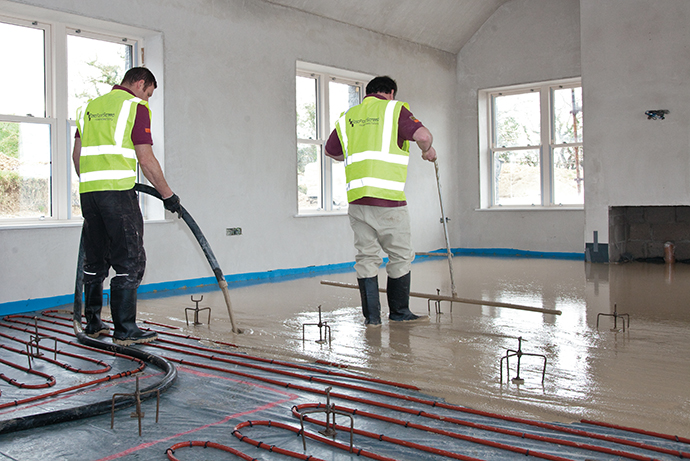The design and installation of screeds are governed by standards which must be adhered to by flooring contractors to ensure trouble-free screed laying. These are: BS EN 13813 – ‘Screed material and floor screeds – Screed material – Properties and requirements’; BS 8204- 1 – ‘Screeds, bases and in-situ floorings. Concrete bases and cementitious levelling screeds to receive floorings – Code of Practice’; BS 8204-7 – ‘Screeds, bases and in-situ floorings. Pumpable self-smoothing screeds – Code of Practice’; and DIN 18560 – ‘Floor screeds in Building Construction’. The specification of a floor screed will vary depending on the requirement for its load- bearing capacity, durability, surface-levelling requirements, final floor covering, time-frame and consideration of environmental aspects.
METHODS
Screed can be installed using three main methods: bonded, unbonded and floating (heated or unheated) screed construction. Bonded screeds are described in BS 8204-1, BS 8204-7 or DIN 18560 Part 3. These are fully bonded to the base. The strength of a bonded screed depends on the type of use. Unbonded screeds are described in BS 8204- 1, BS 8204-7 or DIN 18560 Part 4. These screeds are laid on a separating layer (ie not bonded to the base), as typically a DPM is placed under the screed. Specification of the screed thickness should take account of BS 8204-1, BS 8204-7 and DIN 18560 Part 1.
Floating screeds to BS 8204-1, BS 8204-7 or DIN 18560 Part 2. An insulation layer is used to enable installation of thermal or acoustic insulation. The screed is laid on top of insulation to create a thermally-efficient floor. Floating screeds are commonly used where underfloor heating systems are provided or thermal or acoustic insulation is required. The thickness is determined by the binder type, projected live loads and final floor finish. Heated screed is a floating screed to BS 8204-1, BS 8204-7 or DIN 18560 Part 2, where the floating screed layer is installed over underfloor heating pipes. The screed serves to conduct the heat evenly across the floor surface, avoiding hot or cold spots. In order that heat propagates only in the required direction of the room to be heated or cooled, the elements are inserted above insulating panels.
LAYING
With BS 8204 Part 1 mainly applicable to sand and cement and fine concrete-heated screed constructions, heated levelling screeds are generally laid in conjunction with proprietary underfloor heating systems as floating screeds over thermal insulation. The heating pipes or cables should be secured in position (their installation details should be provided by
the manufacturer of the heating system). Cementitious levelling screeds should be laid at the thicknesses recommended in 6.4.3c (75mm minimum or 65mm for domestic applications) unless otherwise specified by the
manufacturer of the proprietary system. With BS 8204 Part 7 applicable to cementitious and calcium sulphate-based self-smoothing heated screed constructions, the thickness of the screed should be as detailed in section 6.4 (40mm minimum
for commercial and 35mm minimum for domestic applications). It should also ensure a minimum cover over the heating pipes or ables of 25mm for a calcium sulphate-based screed or 15mm for a cement-based screed. Cement-based screeds should not be heated until they are cured and dried because of the increased risk of cracking.
DIN 18560 Part 2 distinguishes between three heated screed constructions. For Construction A (see diagram), the screed thicknesses determined using DIN 18560
Part 2, Tables 1–4 should be increased by the external diameter of the heating pipe. For flexural tensile strength class F4, the minimum pipe cover totals 45mm for cementitious screeds and 40mm for self-levelling calcium sulphate screeds where natural stone and ceramic coverings are installed.
• Example 1. Cementitious screed (CT-F4) t = 45mm. Heating pipe diameter = 15mm ➨ 60mm total screed thickness.
• Example 2: Self-levelling calcium sulphate screed (CT-F4) t = 40mm. Heating pipe diameter = 15mm ➨ 55mm total screed thickness.
AVOIDING FAILURES IN HEATED SCREEDS
Historically, floor screed failures have regularly resulted from the interaction of heated screed constructions with a wide range of coverings. Failure by the contractor to check on residual moisture and consequent installation of coverings on an overly wet screed may have serious implications for
the durability and longevity of the flooring. The maximum permissible residual moisture
bringing european innovation
(measured using a CM tester) is 2% for cementitious screeds and 0.5% for calcium sulphate screeds.
UFH SYSTEMS COMMISSIONING
Apart from measuring the residual moisture in the substrate, the contractor should also examine the commissioning report for the floor heating system and inspect the screed for possible cracking. The commissioning procedure serves to check the performance of the floor heating system and screed. DIN 4725, Part 4 provides for the heating up of cementitious screeds after 21 days, calcium sulphate screeds after seven days, and rapid-set screeds (eg Sopro Rapidur B5) after three days (see graph right).
FAST-TRACK SCREED LAYING
Rapid-Set Systems allow fast-track screed laying in conjunction with UFH. However, it’s inevitable that the lengthy drying
times required for traditional screeds are frequently at odds with tight construction programmes and deadlines. Depending on their coat thickness, standard cementitious screeds need between four and ten weeks to achieve the prescribed 2% CM residual moisture content. The drying process may be accelerated through the use of specially designed binder mixes suitable for the production of cement screeds.
Available from SMET, there are new screed products available, such as Rapidur B5 rapid-set screed binder and Rapidur FE
678 self-levelling screed (ready-to-use dry mix) which can be used to produce screeds that dramatically reduce the time of drying. These allow early flooring installation that complements UFH systems, while exhibiting all the properties of, and delivering the same performance as standard cement screeds.
The use of these new screed products means that tiles may be installed in as little as 24 hours (Sopro Rapidur FE 678) or three days (Sopro Rapidur B5) after screed laying. This has the result of speeding up the entire screed-laying process, allowing quick access to follow-on trades.
If you are a flooring contractor and
wish to discuss these ‘next generation’ screed solutions or you have a job to lay
in combination with UFH, track-track or otherwise, contact the screed specialists at SMET.
Smet Building Products Ltd | 93A Belfast Road | Newry | BT34 1QH | Northern Ireland T: +44 (0) 28 3082 5970 | F: +44 (0) 28 3025 2777 | E: info@smetbuildingproducts.com www.smetbuildingproducts.com or www.smet.ie








